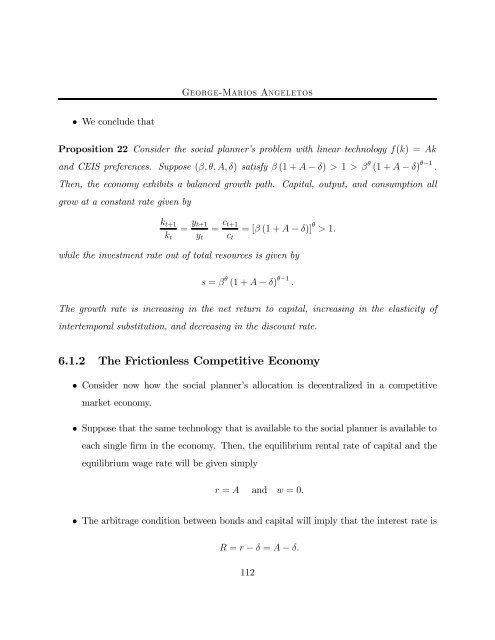14.451 Lecture Notes Economic Growth
14.451 Lecture Notes Economic Growth
14.451 Lecture Notes Economic Growth
Create successful ePaper yourself
Turn your PDF publications into a flip-book with our unique Google optimized e-Paper software.
• We conclude that<br />
George-Marios Angeletos<br />
Proposition 22 Consider the social planner’s problem with linear technology f(k) =Ak<br />
and CEIS preferences. Suppose (β,θ,A,δ) satisfy β (1 + A − δ) > 1 >β θ (1 + A − δ) θ−1 .<br />
Then, the economy exhibits a balanced growth path. Capital, output, and consumption all<br />
grow at a constant rate given by<br />
kt+1<br />
kt<br />
= yt+1<br />
yt<br />
= ct+1<br />
ct<br />
=[β (1 + A − δ)] θ > 1.<br />
while the investment rate out of total resources is given by<br />
s = β θ (1 + A − δ) θ−1 .<br />
The growth rate is increasing in the net return to capital, increasing in the elasticity of<br />
intertemporal substitution, and decreasing in the discount rate.<br />
6.1.2 The Frictionless Competitive Economy<br />
• Consider now how the social planner’s allocation is decentralized in a competitive<br />
market economy.<br />
• Suppose that the same technology that is available to the social planner is available to<br />
each single firm in the economy. Then, the equilibrium rental rate of capital and the<br />
equilibrium wage rate will be given simply<br />
r = A and w =0.<br />
• The arbitrage condition between bonds and capital will imply that the interest rate is<br />
R = r − δ = A − δ.<br />
112

















